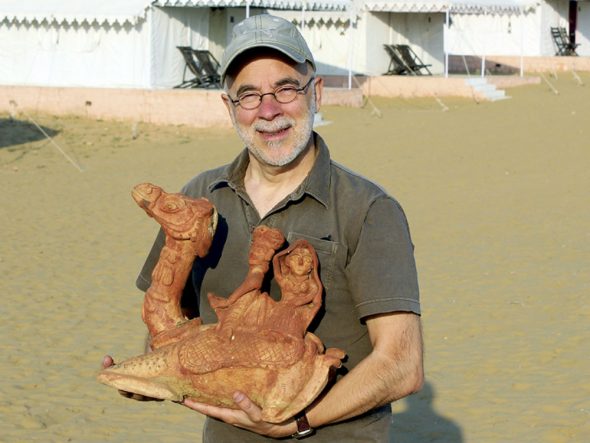by Albert Cormier
The principal reason for my trip to India was to spend three days in the holy city of Varanasi. My ultimate goal was to see the Ganges, this mythical sacred river where each
day thousands of Hindus bathe to purify themselves in water that is
extremely polluted! Each day human and cow cadavers are thrown into it.
After age 65 the majority of Hindus leave their families to come to this place of pilgrimage. All want to die in Varanasi because Hindus believe that if a person dies in this holy city, this person is automatically liberated from the cycle of rebirth.
We attended a purification ceremony at the Ganges, performed by seven Brahmin priests to the sounds of bells and scent of incense. This
ceremony is held each evening at
sunset and attracts thousands of people. The experience is gripping. Our being is awakened by the music and chanting heard on speakers. The
atmosphere engulfs us and reaches into our soul.
The next day, waking at four in the morning, we left on the Ganges. Our guide rented a boat and we traveled
on the river. As the sun rose, more people arrived to get into the water
for purification.
We did not have the right to photograph the women or the funeral pyres. There were large stairs cut from rock descending right down to the river and we saw from both sides, the pyres where the dead are incinerated daily. The ashes were still burning.
Not all Indians have the right to cremation, only those who die a natural death. People who die of an accident, an illness or a murder are not cremated but their bodies are thrown directly into the water. Their brutal deaths can only bear the fruit of bad karma, it is believed.
A bamboo stretcher is used to carry the body to be cremated and the oldest son uses a piece of bamboo to break the skull of the dead in order to facilitate the rising of his spirit. At the end of cremation most of the remains float in the water. The place is summarily cleaned and ready for another body. Cremation is possible through electronic means, it is much less expensive,but this does not fit with tradition. While the bodies burn, the cows and dogs walk around in search of something to eat.
I was told that this symbol is the most auspicious of all. For Hindus it symbolizes the popular god, Ganesh. For good luck to come from all directions, the lines point at the same time to north, south, east and west. For Hindus, the swastika was an important symbol for many thousands of years. Our guide, Rahul Chaula told us the word “swastika” is a Sanskrit word meaning well-being, good existence and good luck. A Sanskrit scholar, P.R. Sarkar, in 1979 said that the deeper meaning of the word is permanent victory.
The original swastika is a symbol of good fortune, abundance and eternity. A drawing of it can still be seen as well on temples, houses, buses, taxis and on the corner of books. It can have positive and negative meaning depending on how it is drawn. The swastika is a symbol used by one of the most hated men on Earth, Adolf Hitler. A symbol that represents the slaughter of millions of people. Hitler perverted this symbol by tilting it to a 45 degree angle and cutting off the curves at the end of each line that represent openness in all directions. In doing so, Rahul said he effectively cut himself off from the world.
The most celebrated monument in India, the Taj Mahal, is also the most perfect mausoleum in its architecture and is one of the seven wonders of the world. All the same, the magnitude of pollution and the seven million visitors each year cause damage to this imposing structure. Luckily the Indian government has imposed major restrictions on traffic and other sources of pollution close to the monument.
There is little trace of degradation, hopefully it will last through the years without deteriorating.
The last moghul emperor married three women, of whom the third was his favourite. The relationship was a good one and when she died in 1631, the emperor ordered the construction of a great mausoleum. Following his death, the emperor’s body was put by her side, in spite of the fact that he remarried several times afterwards. So the Taj Mahal is a tomb, albeit an exceptional one.
The monument was constructed between 1632 and 1648. When the principal architect was chosen, the emperor assassinated the architect’s wife so he would be in the same state of grief as the emperor during construction. It is built in white marble encrusted with semi precious stones. As the marble reflects the sun, the Taj Mahal is visible from 40 km!
Each day is a new experience in India. The food, is excellent. The country of spices offers us a great variety of meals. Morning, noon and night, an all-you-can eat buffet is served. The Indians love spices for their taste and also their health benefits.
For example, turmeric is used as an antibiotic, a blood purifier, and a mosquito repellent. It is used in beauty products and even to dye fabric. For tourists, there are many meals with hot peppers on the menu but mostly spiced to the degree we prefer. Curry is most often used, as are cardamom, cumin and coriander. Indians are mostly vegetarian. They eat meat, poultry or fish every three days. In the north less fish is consumed but when it is prepared, it is excellent. Cows and wild boars roam the streets freely, but they are not on the menu.


Be the first to comment on "Times and Places: Life and death have different meanings in India"